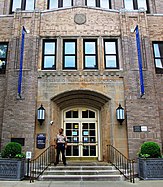Columbia University Irving Medical Center
| Columbia University Irving Medical Center | |
|---|---|
| NewYork-Presbyterian Hospital | |
 | |
 | |
 | |
| Geography | |
| Location | Roughly bounded by: west: Riverside Drive north: West 169th Street east: Audubon Avenue south: West 165th Street, Washington Heights, Manhattan, New York City, New York, U.S. |
| Coordinates | 40°50′28.3″N 73°56′26.9″W / 40.841194°N 73.940806°W |
| Organisation | |
| Funding | Non-profit hospital |
| Type | Teaching |
| Affiliated university | Columbia University |
| History | |
| Opened | 1767 |
| Links | |
| Website | cuimc |
| Lists | Hospitals in U.S. |
Columbia University Irving Medical Center (CUIMC) is the academic medical center of Columbia University and the largest campus of NewYork-Presbyterian Hospital. The center's academic wing consists of Columbia's colleges and schools of Physicians and Surgeons, Dental Medicine, Nursing, and Public Health.
The center's healthcare wing include Morgan Stanley Children's Hospital, New York State Psychiatric Institute, and the Audubon Biomedical Research Park. The center is located in the Washington Heights neighborhood of Upper Manhattan, New York City.
The campus covers several blocks—primarily between West 165th and 169th Streets from Riverside Drive to Audubon Avenue.
History
[edit]The medical center was built in the 1920s on the site of Hilltop Park, the one-time home stadium of the New York Yankees. The land was donated by Edward Harkness, who also donated most of the financing for the original buildings. Built specifically to house a medical school and Presbyterian Hospital, it was the first academic medical center in the world. Formerly known as the Columbia-Presbyterian Medical Center (CPMC), the name change followed the 1997 formation of NewYork-Presbyterian Hospital, a merger of two medical centers each affiliated with an Ivy League university: Columbia-Presbyterian with Columbia University, and New York Hospital-Cornell Medical Center, with Cornell University's Weill Cornell Medical College.
The Medical and Graduate Education Building was designed by architects Diller Scofidio + Renfro and Gensler, and the structural engineer was Leslie E. Robertson Associates.[1]
In September 2016, the campus was renamed as Columbia University Irving Medical Center, for one of the hospital and the university's largest benefactors, Herbert and Florence Irving.[2] Herbert Irving was a co-founder and former vice-chairman of Sysco.
The hospital completed the first successful heart transplant in a child,[3] the first use of the anti-seizure medication, dilantin, to treat epilepsy,[4] and the isolation of the first known odour receptors in the nose.[5]
The institution supported discoveries related to how memory is stored in the brain, and Nobel Prize-winning developments in cardiac catheterization (1956) and cryo-electron microscopy (2017).[6]
In 2023, The Roy and Diana Vagelos Institute for Basic Biomedical Science was established with a $400 million donation from P. Roy Vagelos.[7][8]
Gallery
[edit]- Entrance to the Columbia University Vagelos College of Physicians and Surgeons
- Hammer Health Science Center
- Irving Cancer Research Center
- Russ Berrie Medical Science Pavilion
- Vivian and Seymour Milstein Family Heart Center
- Edward S. Harkness Eye Institute
- Milstein Hospital Building
References
[edit]Notes
- ^ Nadine M. Post (March 24, 2015), Mind-Bender In Upper Manhattan Engineering-News Record. Retrieved October 24, 2019.
- ^ "Columbia University and NewYork-Presbyterian Announce Naming of Medical Campus for Herbert and Florence Irving". PRNewswire. September 21, 2016. Retrieved October 24, 2019.
- ^ Evans, Heidi (April 13, 2003). "TALK ABOUT A GUY WITH A LOT OF HEART 1st kid to get new ticker wants to be doc". New York Daily News. Retrieved October 24, 2019.
- ^ Friedlander, W. J. (1986). "Putnam, Merritt, and the discovery of Dilantin". Epilepsia. 27 Suppl 3: S1–20. doi:10.1111/j.1528-1157.1986.tb05743.x. ISSN 0013-9580. PMID 3527690. Retrieved March 28, 2023.
- ^ Axel, Richard. "SCENTS AND SENSIBILITY: A MOLECULAR LOGIC OF OLFACTORY PERCEPTION" (PDF). Nobel Lecture. The Nobel Prize Committee. Retrieved March 28, 2023.
- ^ Bec Crew (August 27, 2019). "The top 5 healthcare institutions for scientific research in 2018". Retrieved October 24, 2019.
- ^ Armstrong, Katrina A. (August 22, 2024). "Roy and Diana Vagelos Make Historic Gift to Biomedical Science Research and Education". Office of the President (Press release). Columbia University. Retrieved October 14, 2024.
- ^ McFarling, Usha Lee (August 22, 2024). "Columbia medical school gets $400 million gift to fund long-shot basic research". STAT. Retrieved October 14, 2024.


 French
French Deutsch
Deutsch








